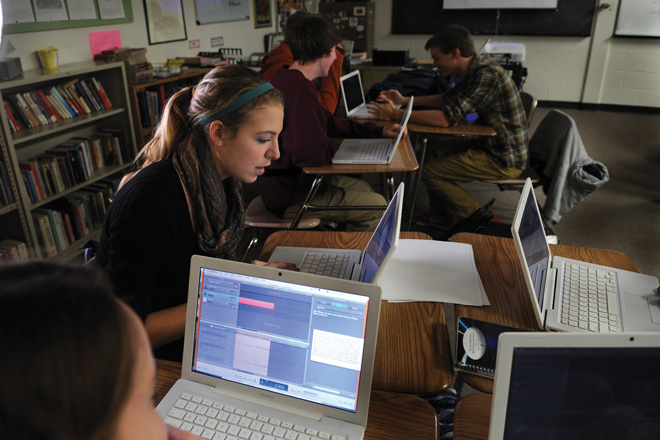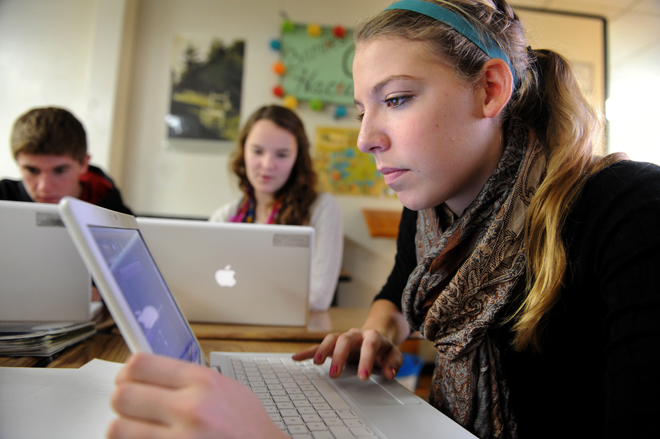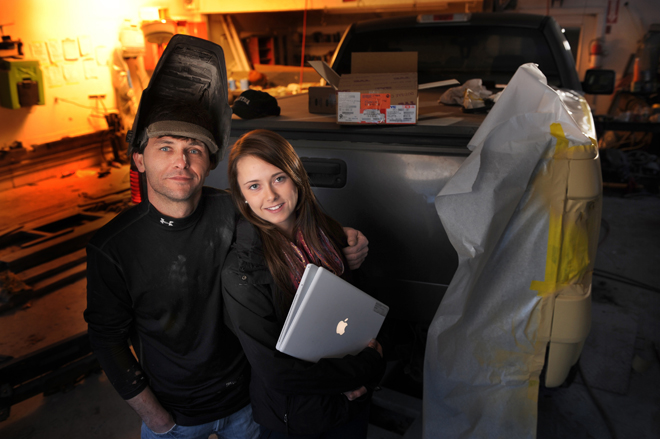The New Digital Citizens
FEATURE-April 2013
By Jaed Coffin
Photographs by Fred Field
Maine’s one-to-one laptop initiative in action—a decade later.
It’s just after ten in the morning on the last day of January, and in Emily Vail’s second-period sophomore English class at Mt. Ararat High School, every student in the room is flipping open his or her laptop for the day. In clusters of four, the white Apple-illuminated shells all look the same. But up close are the symbols of ownership: one girl’s keypad is trimmed with stickers of ironic Disney princesses; another girl’s is decorated with an oval advertising the name of her summer camp. The backgrounds of the screens vary too: a tropical cityscape far from the Maine winter; a fiery blaze through which appear the words: “Whether or not you write well, write bravely.” The majority of the screens, however, look the same: gray, the acronym “MLTI” in the lower right corner. The letters stand for Maine Learning Technology Initiative, the state program that has made these laptops available to every junior-high student in Maine, and provided them to over half of the state’s public high schools. 2013 marks the tenth anniversary of MLTI’s one-to-one laptop initiative, a program that is now so deeply woven into our education culture that the senior class at MAHS—the first class to cycle through the program from start to finish—has never learned without it. Maine is the only state in America with a one-to-one laptop program, and in recent years the program has become a model of social equity and access. States across the nation have tried to imitate MLTI but none has yet succeeded in implementing a program like it.
At the front of the classroom, Lisa Hogan—technology integrator and MLTI pioneer—is handing out thumb drives to each group of four students, for an exercise she calls “Five Card Flickr.” Each drive contains a folder with five photographs downloaded from the photo-sharing website’s royalty-free photo bank. The students pop in the thumb drives and open the folders, and the images blossom on their screens: a pair of dice, a pale and lanky teenage boy, a flower, a parrot, drums, a toddler wearing huge glasses, a tropical island. In pairs, the students get to work, arranging the images in various sequences to tell a story in the form of a play.
“He’s a vampire!” one boy says. “And he likes gambling!” A group of girls in the corner decides that the toddler has been transported to a tropical island, and is asking the parrot how to get home. Now the boy with the gambling vampire has changed his mind: “How about he marries John Lennon, and turns into Yoko Ono! Yes! Yes!” he says. “I’m a genius!” The students deftly type their stories into Word documents, and then open their Facebook accounts—not to chat or browse each other’s profiles, but to send the documents to their partners in preparation for the next step: recording their stories as podcasts that they will later post online.
“Lids down!” Hogan says—and every laptop in the classroom closes. The students turn their attention to the front, where Hogan and a girl named Emma demo on Garage Band software how to record their voices, how to set the words to music, how to align each speaking part with a parade of corresponding images. When Emma plays the finished product of one girl’s story, the class bursts out laughing. The girl calls out, “No way! That’s what I sound like? A four-year-old who just inhaled helium?”
“Now!” Hogan says. “On your own machines, record your story! This should take about two and a half minutes! Let’s go!” The lids flip open, and the students get to work: reading their scripts out loud, editing, setting the words to music they’ve downloaded—legally—onto their machines: Lil Wayne, Kanye West, Wiz Khalifa.
Meanwhile, Emily Vail stands in the back of the room, her arms crossed, smiling but looking a little bit perplexed. “You think they’re engaged?” she says. The goal for today’s lesson is to introduce to her students the necessary tools to podcast their modern adaptation of a scene from Hamlet. “I just want them to think of themselves as creators,” Vail says. “And I didn’t want them writing just another paper. I want them to use technology to actualize their ideas. To dramatize their creativity.”
In a week, the students will be required to deliver graphic images to use as the cover page of their adaptations—like a playbill for a Broadway show. One girl, who happens to be a very talented artist, will make a watercolor painting, scan it, and use that as her front page. Ultimately, the students will submit these scripts to the Portland Stage Company’s Young Playwright Competition.
Vail is a petite woman with short hair and spectacles who looks like an English teacher from a movie about an English teacher; on the walls of her classroom are portraits of Shakespeare and Eleanor Roosevelt, quotes from James Baldwin, and a poster displaying the lineage of great American poets from the 1800s to the present. The bookshelves along the walls are filled with copies of Roget’s Thesaurus, novels, the Odyssey—books, Vail tells me, that don’t get much use anymore. When I ask her if she’s concerned that technology is compromising the sacredness of literature, Vail winces.
“These kids are all digital natives,” she says. “I’m not. All of this can only extend what they do in my classroom. It gets them psyched, and engaged.” She gestures quietly to a group of boys in sports attire who earlier told me that their hobbies were snowmobiling, football, lifting weights, riding dirt bikes and, unanimously, fishing. “I mean they all just created their own podcasts!” she says. “You know, sometimes you have to catch your bees with honey.”
When the bell rings, Hogan tells the students to email her with any questions, which she promises to answer promptly. In the event that they want to figure it out for themselves with online tutorials, Hogan tells them, “Remember: YouTube is your friend!”
Earlier that morning, I sat with Hogan in her empty classroom. The desks were arranged in small groups. There were no computers anywhere. It was the modern version of my Computer Applications classroom in the late ’90s, across the river at Brunswick High School. Back then, we sat in long rows, half asleep behind the monitors of massive desktops, watching an instructor with a red laser pointer explain how to use Excel. The computers didn’t come home with us, and we spent perhaps an hour each week in front of an impersonal screen. Four years after I graduated—by then it was 2003—I began to see all the kids in my neighborhood whom I used to babysit walking home from school with little black cases at their hips. Those seventh-graders are now seniors, set to graduate in the spring.
Back then, Hogan told me, “there was energy all through the school.” At the time, Hogan was an eighth-grade classroom teacher at Mt. Ararat Middle School. As the MLTI vision under then-governor Angus King gained momentum, Hogan said, “I had the feeling that everything I had learned as an educator in the last 20 years was about to change.” Under her principal at the time, the current president of the Maine International Center for Digital Learning, Bette Manchester, Hogan told the IT personnel at MAMS, “I could care less about word processing. Show me what these things can really do!” The moment she realized that she could connect and share information with other like-minded teachers across the country through the simple innovation of an email account “changed everything.”
“I’ve always been one of those Lewis and Clark type of people,” Hogan said. The daughter of a father who was one of the early engineers behind the Martin Marietta missile development programs, and a mother who worked as a registered nurse, Hogan was surrounded by science. As a young girl, when she asked her father how to solve a problem, she recalls him saying, “Let’s see how it can be done.” After graduating from Plymouth State College with a degree in education, and moving to Maine, where she taught at an elementary school in Harpswell, Hogan felt as if she’d let her parents down. She wasn’t an engineer, or a scientist—but an educator, in a rural state. “I always wanted to be a teacher,” Hogan told me, “Not because I was bossy but because I really wanted to help people.”
It was in the elementary classroom—where students are “constantly being grouped and regrouped”—where she realized that learning is often more about process and problem solving than accessing or memorizing static information. Soon, Hogan’s reputation as a tech-savvy educator began to grow. In 2006, she was invited to the National Science Teachers Association Conference to speak about the success of laptops and technology in Maine classrooms. In 2008, SAD 75—the school district which includes Mt. Ararat Middle and High School—hired her to be the technology integrator for K-12. Currently, she serves as the technology integrator for grades 6-12 and is known statewide for being one of the original minds of MLTI.
“I worked so hard the year that laptops came out. The fallacy,” Hogan explains, “is that technology makes teaching easier. But it actually allows you to do things you couldn’t do before, which is much, much harder.” In the last decade, Hogan believes that teachers have been under immense pressure to produce what she calls “single measurement” classroom results: in short, standardized forms of testing like Advanced Placement scores and SATs. “As teachers,” she said, “when there’s stress, you just do what works instead of trying something new and different. When you’ve got 20 students with APs to get through, how are you supposed to take risks, to be innovative?”
Now, Hogan says, the most successful teachers are like Emily Vail: the ones who don’t revolutionize their pedagogical methods overnight, but take a “slow and steady approach.” Every year Vail comes to Hogan with a new goal she’d like to achieve in her classroom—what Hogan refers to as a “learning outcome.” Hogan doesn’t think of herself as a “device person,” but rather sees her role and the role of the IT department at MAHS as bound to teachers in a “symbiotic” relationship, focused on developing the best education for every student.
On the way to the cafeteria, Hogan tells me that one of the biggest challenges of the laptop program has been figuring out how to mediate the relationship between the machine and the student. At MAHS, students are allowed to use Facebook, they’re allowed to download their own music on their machines, and they’re allowed to watch videos at lunch. In order for the program to be successful, Hogan says, the student needs to have a sense of ownership and accountability. “I had to ask myself: what do I do during lunch? I read the New York Times—online. So they should be able to make those choices, too.”
Amidst the thrum of the lunch period, students sit eight and nine to a table. As they eat, the laptops remain hidden in slim black bags. Ten minutes later, roughly three quarters of the students are staring at screens. A quick survey yields that there is no typical use for the laptops at lunch. One girl is doing her chemistry homework. Several boys are playing an online game called Dragon City. Several other boys are watching “fail videos” and everyone else seems to be checking Facebook. I ask one boy reading the BBC network what makes him different.
“I just want to see what’s going on in the world,” he says. Another group of boys is laughing about a notice one of them has received that someone in a city in Egypt has attempted to hack into their email account. A boy sitting next to him brings up a map of Africa. “Where’s Egypt?” he asks, then zooms in. “Here,” he tells the victim. “That’s where they are.”
The bell rings, there’s a great deal of bustle and zippering, and all the students funnel into the hallways, backpacks on one shoulder, black cases swinging at their hips. If I didn’t know any better, I’d think I was in Grand Central Station during rush hour, but one bag—adorned with a “Grunden’s: Eat Lobster” sticker—reminds me that I’m at a high school in Maine, where many of the students come from the farming community of Bowdoinham or the fishing communities of Bailey Island and Harpswell.
Toward the end of the day, as I’m passing the MAHS library, I stop in front of column of familiar machines: a dozen or so five-foot-tall overhead projectors stand next to four massive wheeled media carts holding televisions and VCRs. Tricia Gordon, a MAHS graduate and now library assistant with two boys in the SAD 75 school system, tells me that the machines still get some use. “Not everything can be streamed on Netflix or Hulu,” she says. As a lover of technology, she embraces the technology-based education that her children receive. “In Maine,” she says, “we’re blocked off from a lot of the rest of the country. So, we’ve got to get this stuff to our kids. The whole world is right at their fingertips.” Gordon’s mission as a parent, however, is to provide lessons of what she calls “digital citizenship,” teaching kids not to text in public, or answer their phones in the middle of conversations. “That’s on the parent,” Gordon says.
Beyond the old machines, laid out on a couch with a computer in her lap, is Sonja Robert. At first, she looks like a stereotypical teenage girl: Ugg boots, buds in her ears, tattoo on her forearm, oblivious to the world around her. But when I ask her what she’s up to, I find that I’m the oblivious one. The daughter of an auto mechanic and an employee of Mid Coast Hospital, Robert tells me that next fall she’s headed to UMaine’s engineering program. Robert is of that first generation of seventh-graders who were given laptops ten years ago. Of course you can’t draw a straight line between Lisa Hogan’s vision and Sonja Robert’s imminent future, but it’s hard not to feel like something important has finally come full circle. When I ask Robert what her laptop is most useful for, she tells me, “physics, writing papers.” I ask her what her mother thinks of the white machine she brings home every night. “She thinks it’s really useful,” she says. “For what?” I ask her. “Well, like the other night,” Robert says, “when we filled out my FAFSA forms for UMaine. The financial-aid application now resides primarily online. I ask Robert what she thinks her life would have been like without the laptop and she shrugs.
“I think it just makes everything in life a whole lot easier,” Robert tells me with conviction—as if she had ever known it any other way.
























